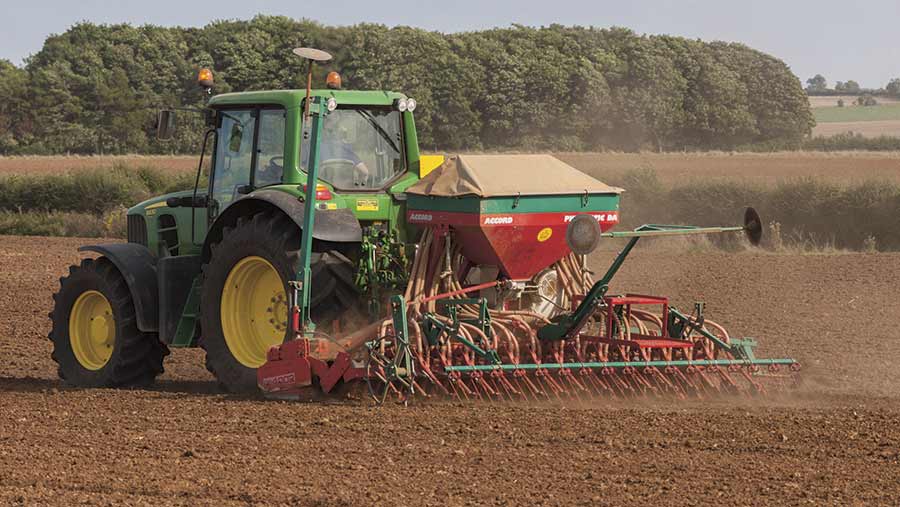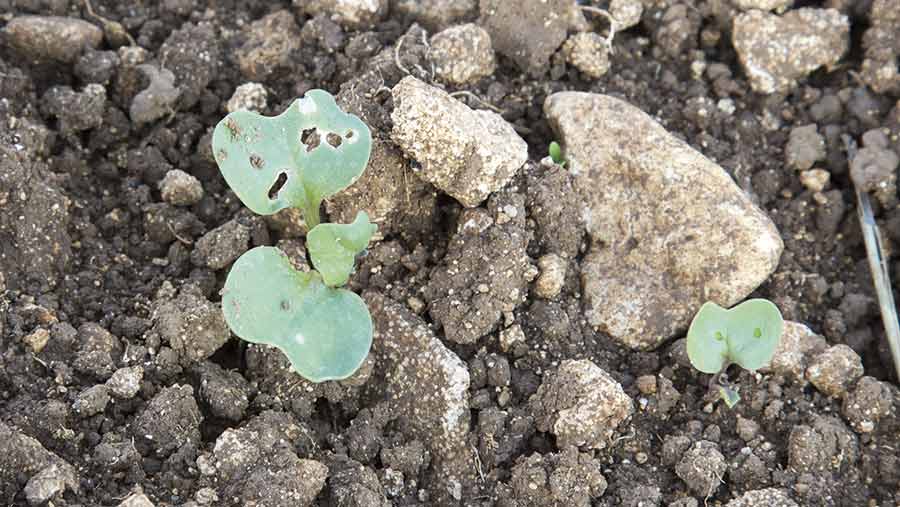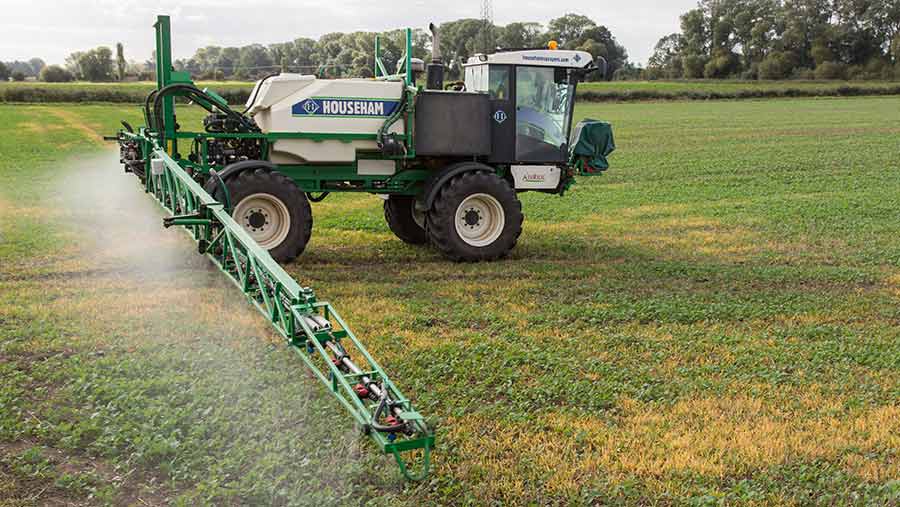Advice on establishing oilseed rape in difficult conditions
Early drilling into a good seed-bed with adequate moisture is the key to growing oilseed rape successfully, allowing seeds to germinate and establish quickly.
This will allow crops to outgrow potential damage from pests such as slugs, pigeons and cabbage stem flea beetles, and to generate good biomass above and below ground before winter.
Mid- to late-August is seen as optimum for sowing rapeseed in many regions and, given reasonable moisture, should help crops establish before the main migration of adult flea beetles, which occurs in early to mid-September.
See also: Harvest 2017: Early rapeseed yields better than expected in dry year

© Tim Scrivener
Busy workloads and unreliable rainfall can make it hard to achieve ideal seed-beds and experts advise against self-imposed drilling deadlines, urging growers to be patient and not force crops into very dry or cloddy seed-beds.
Flexible timing
“Whatever establishment method you use, be flexible and drill when conditions are right,” says Essex-based Prime Agriculture agronomist Andrew Blazey.
“Whether you are seeding after primary cultivations or direct into stubbles, you need fine, moist, well-consolidated soil around the seed,” he adds.
Large amounts of soil disturbance and cloddy seedbeds create ideal conditions for pests to hide and thrive, so must be avoided. Rolling after drilling further reduces these hiding places and improves seed-to-soil contact.

© Tim Scrivener
There may be scope to delay drilling until after the main flea beetle migration period, says Steve Ellis from crop consultants Adas. However, this needs to be balanced with the risk of not establishing a strong enough crop to get through winter.
This issue is especially acute on heavy ground or in wooded areas where pigeons are a major problem, making drilling beyond early September unfeasible for many, notes Mr Blazey.
Varietal vigour
There is some debate as to whether varieties offer tangible differences in autumn vigour, but it is a factor to consider when deciding what to grow.
Breeders insist many hybrids and some conventional varieties do have faster growth in both autumn and spring, although this may not always be reflected by AHDB Recommended List trials.
“There are varietal differences in early vigour, but it’s very hard to define. Hybridisation has provided a large number of opportunities and different traits, so you’ve got to choose what works best on an individual field basis,” says Andy Stainthorpe of plant breeders Pioneer.
David Leaper of agronomy group Agrii says differences in autumn vigour go beyond “hybrid versus conventional”.
“There are some fast- and slow-developing hybrids and conventional varieties available, with seed size often having a bigger impact on early vigour,” he says.
Growth habits
Varieties with slower autumn growth habits such as Sparrow, Alize, Butterfly and PT256 are more suited to very early sowing or higher fertility sites, whereas faster-developing types such as many Monsanto varieties and others such as Nikita, Architect and InVigor 1035 may be more suited to later sowing.
“Pick your variety according to the drilling window, soil conditions, fertility and disease risk. The last thing you want is for early-sown crops to get too proud and elongated in autumn because this can weaken stems in spring,” he adds.
Mr Leaper also warns that drilling early can increase clubroot risk, especially where conditions are warm and wet.
This can be exacerbated by tight rotations. Verticillium is another disease to be wary of on tight rotations (one year in four or less), with risk increased by early sowing, says Mr Blazey.
Winter damage
Simon Kightley at crop consultants Niab believes autumn vigour differs very little between varieties, although he says there can be noticeable differences in spring vigour, which helps crops recover from winter damage.
He highlights the trend of growers sowing cheaper conventional seed at a higher seed rate to offset pest losses and minimise the financial risk in the event of crop failure.
Suffolk agronomist Alan Dewar says increasing seed rates may help mitigate flea beetle damage, although there is no scientific evidence to support this.
“It’s reasonable to assume that having more plants means fewer beetles and less damage per plant compared with sowing at lower seed rates,” he adds
Growers must be prepared to switch to an alternative break crop if conditions are not suitable for rapid establishment within the drilling window, especially in flea beetle hotspot areas in the southeast of England, says Dr Dewar.
Fertility boost
Phosphite seed treatments are a cost-effective way of stimulating root development and early growth, while starter fertilisers of diammonium phosphate (DAP) or specialist nitrogen, phosphate and boron mixes applied in the row also boost establishment chances, says Mr Leaper.
Oilseed rape readily utilises nitrogen in autumn and placing fertiliser close to seeds allows more efficient uptake by young plants than surface applications, he says. Digestate from anaerobic digestion is also a useful fertility booster where available.
“The most vulnerable time for oilseed rape is from cotyledon stage to first leaf, so anything that gives crops a boost and shortens that gap increases the chances of staying ahead of pest threats,” adds Mr Blazey.
Dr Dewar is more cautious about the benefits of starter fertilisers. “In principle they should work, but if conditions are very dry you won’t get the uptake anyway.”
Reducing weed competition
While some growers are reluctant to spend money on pre-emergence herbicides until they are sure oilseed rape has established, experts say this is a risky strategy that may compromise crop establishment if weed competition is high.

© Tim Scrivener
“If fields are clean then you may be able to gamble and not use a pre-em, but if there’s a lot of charlock or hedge mustard for example, it is worth applying clomazone-based pre-em or consider growing a Clearfield variety,” says Mr Blazey.
Mr Leaper cautions against early drilling where weed pressure is high and also believes herbicide-tolerant Clearfield varieties can play a useful role.
As well as allowing a wider window for weed control post-emergence, they can help mitigate any impact on oilseed rape establishment of sulfonylurea residues from a preceding cereal crop.
Tolerate damage
Once established and beyond the three to four leaf stage, Dr Ellis says oilseed rape is a very resilient crop with an impressive ability to compensate for pest damage, so growers should not be hasty in writing crops off.
“Establishment is key for oilseed rape, but once it is above ground it is generally quite robust with an inherent tolerance to loss of green leaf area,” he says.
Research group Fera is expanding its “smart spore trapping” disease alert project to oilseed rape from September.
The automatic disease monitoring system uses in-field pathogen detection, weather recording and computer modelling to detect disease spores in crops and forecast outbreaks before symptoms are visible.
It is already used to detect septoria and rusts in wheat, and will be trialled for real-time forecasting light leaf spot, phoma and sclerotinia from this autumn, says Judith Turner at Fera.
Although the project is still at an early stage, she hopes better detection and prediction of key pests and diseases will help improve product selection, timing and efficacy of control options.
Oilseed rape establishment tips
- Check rotational position – allows timely establishment and minimises risk of sulfonylurea residues from previous cereals
- Ensure soil nutrition is up to scratch
- Select varieties with fast autumn growth
- Sow early, but only if seed-beds are fine and moist
- Be prepared to wait for right conditions or switch to alternative crop if drilling cut-off is passed
- Consider starter fertiliser with seed
- Increase seed rate
- Consolidate seed-beds
- Use pre-em herbicide where weed pressure dictates
- Monitor pest pressure from before drilling – treat where necessary
- Night spraying may give slight uplift in cabbage stem flea beetle control from pyrethroids
- Control autumn diseases with robust fungicide, particularly light leaf spot and phoma.

